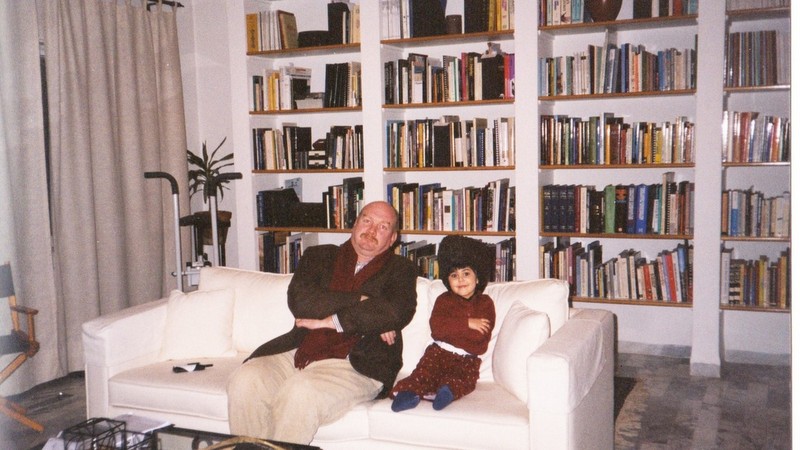A February 2000 photo of Ali Maher and my four-year-old daughter Huda wearing his Circassian hat.
I cannot remember when I first met Ali Maher. I feel as if I had always known him. I think it was in 1994, soon after he became the director of Darat al-Funun. Our families had known each other since the 1930s, when Amman was still a town of only a few thousand people. Because of this, Ali and I felt a special connection very early on. Ever since we met, I considered him a good friend. I had not seen Ali as often as I would have liked and as often as I should have over the past few years. I always felt there will be tomorrow. I obviously was wrong. We had agreed a few months ago that he would come to our house for dinner, and I would bring large sheets of paper so that he would give my teenage daughter and son a drawing lesson. Both had spent some time with him the last time he came over to dinner about a year ago. Although they usually make sure to avoid socializing with their parents’ friends, they could not resist Ali and were overtaken by his contagious laughter, warmth, and sense of humor. Needless to say, we unfortunately never got around to organizing the dinner.
I recall so many memories that show how remarkable a person Ali was. He loved life, but was very well aware of its tragic dimensions. He also loved people, and people loved him. He identified something special in everyone he met.
He did not take good care of himself. Many of us urged him to take better care of himself, but he did not listen.
He was an incredible storyteller. The simplest daily event, to which most of us would not pay any attention, for him was a fascinating opportunity for interaction with people and places. It seems as if every time I saw him, he had a new story to tell about something that had just happened to him. He also told me so many stories about growing up in his beloved Amman, about studying architecture in Russia, and about specific episodes in his life, such as accompanying his mother to the Hajj. I remember them all. They are perceptive, full of humor, and identify something about human nature we may have not noticed before. I love to retell those stories to others, to those who knew him and to those who didn’t, even though I know I cannot make them as interesting as he did.
He was an enabler. He made things happen, and he helped people make things happen. An example of this is when we started a public lecture series and an architectural forum at the Center for the Study of the Built Environment (CSBE) back in 2000, soon after CSBE was founded. We faced difficulties finding a suitable venue for these events. I casually mentioned our difficulties to Ali, and he immediately told me that we should consider Darat al-Funun as our home. We have been holding lectures, forums, and courses there since then, even after Ali left the Darat. He welcomed all to the Darat.
I saw Ali interact with royalty, and I saw him interact with the simplest of people. He treated all with the same sense of courtesy, respect, and pleasantness.
I have met many people who studied drawing, painting, or architectural design with Ali. They of course all loved him. He gave them self confidence. He encouraged them to break the boundaries that both they and society had built around them over the years and to fully and freely explore their creative energies. He was a great teacher.
And of course, there are his paintings. The most famous of them is that of the winged angel holding a tray of the Jordanian mansaf dish, with two cherubs flying on her sides, one holding a tray of the kinafeh sweet, and the other holding fruits. I had seen that painting change and evolve over the years as he would work it over and modify it. I saw how Ali explained it to visitors, often telling them about deep symbolic significances that he would invent on the spot before confessing that it simply was about a beautiful woman and good food. His paintings essentially were part of his storytelling repertoire, and he communicated with people through them.
By his presence, he reminded us that there is kindness in this world. I could never imagine him being mean to anyone in spite of his repeated – but unconvincing – insistence that he could. I never saw him take advantage of anyone. He was a big man with a very big heart that had room for all.
——
To commemorate and honor the late Jordanian architect and artist Ali Maher (1956 – 2013), the Center for the Study of the Built Environment (CSBE) has started a Tumblr and a Facebook page to share experiences and memories about Ali. You can now start sharing your memories by submitting them on the tumble blog or Facebook page.
